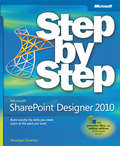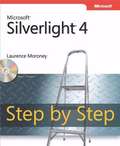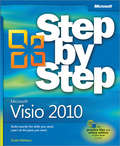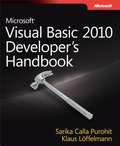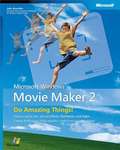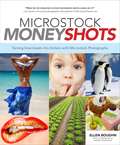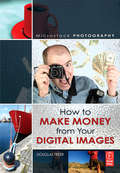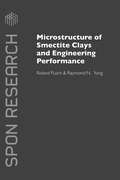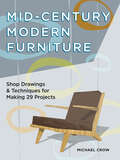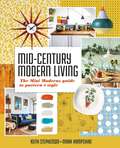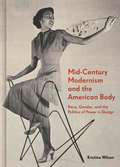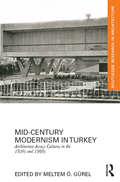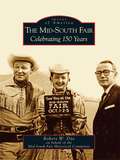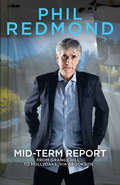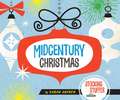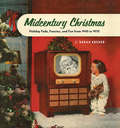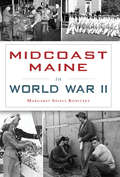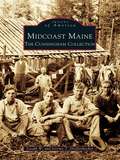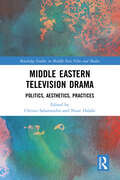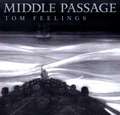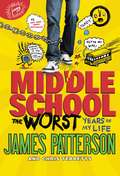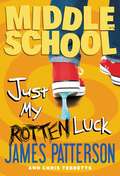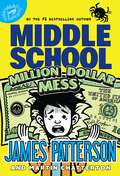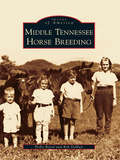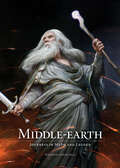- Table View
- List View
Microsoft® SharePoint® Designer 2010 Step by Step
by Penelope CoventryThe smart way to build applications with Microsoft® SharePoint® Designer 2010 -- one step at a time! Experience learning made easy -- and quickly teach yourself how to create SharePoint 2010 applications and workflows with Microsoft® SharePoint® Designer 2010. With Step by Step, you set the pace -- building and practicing the skills you need, just when you need them! Design solutions to meet your business scenario -- without code Customize lists, libraries, and SharePoint site pages Use Web Parts to display, edit, and modify list item data Access data from a variety of external sources Create workflows to automate business processes Use master pages and CSS to control how sites work Your Step by Step digital content includes: All the books practice files -- ready to download and put to work. Fully searchable online edition of this book -- with unlimited access on the Web. The print version of this book includes free digital content online. To download, please visit O'Reilly's web site, search for the title of this book to find its catalog page, and click on the link below the cover image (Examples, Companion Content, or Practice Files). Note that while we provide as much of the media content as we are able via free download, we are sometimes limited by licensing restrictions. Please direct any questions or concerns to booktech@oreilly.com.
Microsoft® Silverlight® 4 Step by Step
by Laurence MoroneyTeach yourself how to build rich Internet applications with Silverlight 4--one step at a time. With this practical, learn-by-doing tutorial, you'll learn how to create interactive user interfaces for the Web and the newest version of Windows Phone by mastering the essential tools and techniques for Silverlight. Install the tools you need and build your first Silverlight application Get up to speed on Silverlight 4 features, including out-of-browser support, webcam, and microphone Develop Web applications with Silverlight that work across browsers and devices Engage users with animation, video, layout, vector graphics, and 3D effects Learn how to build and deploy simple applications for Windows Phone 7 Create Windows Phone features such as Input Scope, Orientation, and the Application Bar Your online learning resources include: Practice exercises Code samples Fully searchable ebook A Note Regarding the CD or DVD The print version of this book ships with a CD or DVD. For those customers purchasing one of the digital formats in which this book is available, we are pleased to offer the CD/DVD content as a free download via O'Reilly Media's Digital Distribution services. To download this content, please visit O'Reilly's web site, search for the title of this book to find its catalog page, and click on the link below the cover image (Examples, Companion Content, or Practice Files). Note that while we provide as much of the media content as we are able via free download, we are sometimes limited by licensing restrictions. Please direct any questions or concerns to booktech@oreilly.com.
Microsoft® Visio® 2010 Step by Step
by Scott A. HelmersExperience learning made easy--and quickly teach yourself how to create professional-looking business and technical diagrams with Visio 2010. With Step by Step, you set the pace--building and practicing the skills you need, just when you need them! Build a variety of charts and diagrams with Visio templates Draw organization charts, floor plans, flowcharts, and more Apply color, text, and themes to your Visio diagrams Use Visio shapes to link to, store, and visualize data Collaborate on diagrams with Microsoft SharePoint® 2010 Create custom diagrams with your own shapes and templates Your Step by Step digital content includes: All the book's practice files--ready to download and put to work. Fully searchable online edition of this book--with unlimited access on the Web. Free online account required.
Microsoft® Visual Basic® 2010 Developer's Handbook
by Klaus Löffelmann Sarika Calla PurohitYour expert guide to building modern applications with Visual Basic 2010 Take control of Visual Basic 2010--for everything from basic Windows® and web development to advanced multithreaded applications. Written by Visual Basic experts, this handbook provides an in-depth reference on language concepts and features, as well as scenario-based guidance for putting Visual Basic to work. It's ideal whether you're creating new applications with Visual Basic 2010 or upgrading projects built with an earlier version of the language. Discover how to: Use Visual Basic 2010 for Windows Forms and Windows Presentation Foundation projects Build robust code using object-oriented programming techniques, such as classes and types Work with events and delegates--and add your own events to custom classes Program arrays, collections, and other data structures in the Microsoft .NET Framework Solve problems quickly and easily using My namespace in Visual Basic Dive into Microsoft LINQ, including LINQ to XML and LINQ to Entities Tackle threading, multitasking, and multiprocessor development and debugging
Microsoft® Windows® Movie Maker 2: Do Amazing Things
by John Buechler<div xmlns="http://www.w3.org/1999/xhtml"><p>Express your creativity and share home movies with this fun and focused guide to Microsoft Windows Movie Maker 2. Discover how to create and edit great footage; create special effects; add music and narration; and more!</p></div>
Microstock Money Shots: Turning Downloads into Dollars with Microstock Photography
by Ellen Boughn Andres RodriquezToday's online microstock agencies make it possible for anyone with a camera to sell their photographs. But the competition is daunting--one leading agency receives 14,000 uploads each day. How can you make your images stand out--and better yet, sell? In this guide, industry veteran Ellen Boughn reveals everything you need to know, including: . How to get started selling your photos. What sells and what doesn't. How to cast and work with models. The fine print on permits and permissions. How to reach specialty markets like advertising, retail, news, and education Packed with hundreds of examples of photos that sell (and some that don't), Microstock Money Shots is your key to maximizing views and downloads in the exciting new world of microstock.From the Trade Paperback edition.
Microstock Photography: How to Make Money from Your Digital Images
by Douglas FreerBe a part of one of the world's fastest growing imaging phenomenons: microstock photography. Microstock photography provides both professional and amateur photographers an opportunity to diversify their income and expand their artistic visibility by turning day trip photos or photography portfolios into viable business investments.Douglas Freer has written a comprehensive book that details the technical and commercial processes of the microstock industry. A must read for entrants into the microstock photography field, Microstock Photography shows you how to: .Choose the right microstock agency.Shoot work that will sell.Navigate the strict technical requirements.Understand the likely financial returns.Review licensing models.Understand copyright issuesOver 60 illustrations and photographs help you improve your skills, learn new techniques specific to shooting stock photography and better understand what the microstock market demands. Anyone can shoot digital stock photography, but in order to make money and be successful, you need the practical advice that can only be found in this book.
Microstructure of Smectite Clays and Engineering Performance
by Raymond N. Yong Roland PuschCertain wastes such as nuclear wastes, are so hazardous that their disposal creates a major challenge requiring considerable technical skill and understanding. Their effective isolation in the ground depends on the properties of the surrounding clays. This authoritative book explains the detailed function of clay-based engineered barriers, gives a
Mid-Century Modern Furniture: Shop Drawings & Techniques for Making 29 Projects
by Michael CrowMinimalist design--maximum style! In the middle of the last century, a new generation of designers sought to render furniture to its most essential forms. In doing so, they created timeless designs that defined Mid-Century Modern Style. From the sleek geometric lines of Bauhaus-inspired design to the sculptural shapes of Danish masters, this furniture captured the imagination of the era and enjoys growing popularity today. Now for the first time, author Michael Crow has carefully detailed 29 seminal works by the era's foremost designers, including Hans Wenger, Finn Juhl and George Nelson. At their best, these spare, often sculptural designs transcend their period and are at home in a variety of settings. Each piece has been selected carefully so it can be built in an average workshop. Inside this book you'll find: More than 100 drawings with exploded views, elevations and details for projects to fit every room in your house. Practical advice on wood selection, hardware sources and contruction and finishing techniques. Two step-by-step project builds. A richly illustrated historical overview tracing the evolution of the style and exploring the designers and makers who shaped it.
Mid-Century Modern Living: The Mini Modern's Guide to Pattern and Style
by Keith Stephenson Mark HampshireBursting with beautiful ideas for bringing a signature mid-century look into your own space, as well as practical advice on what will work where, this is an essential guide for any lover of interior design and mid-century style. In this beautifully photographed book, Mark and Keith of Mini Moderns show you how to create a timeless mid-century look in your own home.Known for their striking use of pattern and colour, Mark and Keith's designs are inspired by everything from childhood memories to commentaries on popular culture, and through this lens they explore how different influences and designers have created key mid-century looks. They delve into the cornerstones of mid-century style, from colour and pattern to materials and curation, and share their secrets on how to bring together the things you love to create your own look. They also include inspirational case studies to demonstrate particular looks, from Beatnik Beach House to Scandi Rustic, Seaside Modern to Studio Townhouse.
Mid-Century Modernism and the American Body: Race, Gender, and the Politics of Power in Design
by Kristina WilsonThe first investigation of how race and gender shaped the presentation and marketing of Modernist decor in postwar AmericaIn the world of interior design, mid-century Modernism has left an indelible mark still seen and felt today in countless open-concept floor plans and spare, geometric furnishings. Yet despite our continued fascination, we rarely consider how this iconic design sensibility was marketed to the diverse audiences of its era. Examining advice manuals, advertisements in Life and Ebony, furniture, art, and more, Mid-Century Modernism and the American Body offers a powerful new look at how codes of race, gender, and identity influenced—and were influenced by—Modern design and shaped its presentation to consumers.Taking us to the booming suburban landscape of postwar America, Kristina Wilson demonstrates that the ideals defined by popular Modernist furnishings were far from neutral or race-blind. Advertisers offered this aesthetic to White audiences as a solution for keeping dirt and outsiders at bay, an approach that reinforced middle-class White privilege. By contrast, media arenas such as Ebony magazine presented African American readers with an image of Modernism as a style of comfort, security, and social confidence. Wilson shows how etiquette and home decorating manuals served to control women by associating them with the domestic sphere, and she considers how furniture by George Nelson and Charles and Ray Eames, as well as smaller-scale decorative accessories, empowered some users, even while constraining others.A striking counter-narrative to conventional histories of design, Mid-Century Modernism and the American Body unveils fresh perspectives on one of the most distinctive movements in American visual culture.
Mid-Century Modernism in Turkey: Architecture Across Cultures in the 1950s and 1960s (Routledge Research in Architecture)
by Meltem Ö. GürelMid-Century Modernism in Turkey studies the unfolding of modern architecture in Turkey during the 1950s and 1960s. The book brings together scholars who have carried out extensive research on post-WWII modernism in a global context. The authors situate Turkish architectural case studies within an international framework during this period, providing a close reading of how architectural culture responded to ubiquitous post-war ideas and ideals, and how it became intertwined with politics of modernization and urbanization. This book contributes to contemporary scholarship to reconsider post-war architecture, beyond canonical explanations.
Mid-South Fair: Celebrating 150 Years, The (Images of America)
by Robert W. Dye Mid-South Fair Historical CommitteeEstablished in 1856 by the Shelby County Agricultural Society, the Mid-South Fair celebrates its 150th anniversary in 2006. Memphis, known as the cotton capital of the South, depended on agriculture for much of the 19th century, and the fair offered farmers and the general public a venue to learn of new products and to compete with others from the region. Through the Civil War, yellow fever epidemics, and two world wars, the fair has prevailed to become one of the largest in the nation. It has been a part of many lives and formed many memories of rides and rodeos, cotton candy and pronto pups, and that first big drop on the roller coaster. The Mid-South Fair: Celebrating 150 Years brings back those memories through words and photographs, taking the reader back to a time when excitement was only a ride away on an old wooden roller coaster.
Mid-Term Report
by Phil RedmondA masterclass in media studies from the creator of Grange Hill, Brookside and Hollyoaks. Described in Parliament as 'excellent' by Ed Vaizey, The Parliamentary Under-Secretary of State for Culture, Media and Sport GRANGE HILLSwimming pool disasters. Drugs, and just say ‘no’. Flying sausages. School like you’d never seen it before.BROOKSIDELesbian kisses. Bodies under patios. Exploding shops. Suburban life like you’d never seen it before.HOLLYOAKSBad boys on bikes. Loveable geeks. Leggy blondes. Students like you’d never seen them before.PHIL REDMONDThree classic TV programmes. One TV genius. This is the behind-the-scenes story of how a working-class lad from the Liverpool suburbs went from living on a housing estate to buying one, and from comprehensive school dinners to lunch with the Queen. Along the way he learned a lot of lessons, broke all the rules, and changed television for ever.
Midcentury Christmas Stocking Stuffer Edition (Stocking Stuffer Edition)
by Sarah ArcherA celebration of (vintage) Christmas past Midcentury America was a wonderland of department stores, suburban cul-de-sacs, and Tupperware parties. At Christmastime, postwar America’s dreams and desires were on full display, from shopping mall Santas to shiny aluminum Christmas trees, from the Grinch to Charlie Brown’s beloved spindly Christmas tree. With more than 100 colorful illustrations and iconic designs, Sarah Archer celebrates the turning point of Christmas in America, when new technologies and unprecedented prosperity made anything seem possible. Midcentury Christmas is sure to be on everyone’s wish lists.
Midcentury Christmas: Holiday Fads, Fancies, and Fun from 1945 to 1970
by Sarah ArcherA celebration of Christmas in the 1950s and '60s Midcentury America was a wonderland of department stores, suburban cul-de-sacs, and Tupperware parties. Every kid on the block had to have the latest cool toy, be it an Easy Bake Oven for pretend baking, a rocket ship for pretend space travel, or a Slinky, just because. At Christmastime, postwar America's dreams and desires were on full display, from shopping mall Santas to shiny aluminum Christmas trees, from the Grinch to Charlie Brown's beloved spindly Christmas tree. Now design maven Sarah Archer tells the story of how Christmastime in America rocketed from the Victorian period into Space Age, thanks to the new technologies and unprecedented prosperity that shaped the era. The book will feature iconic favorites of that time, including: * A visual feast of Christmastime eats and recipes, from magazines and food and appliance makers * Christmas cards from artists and designers of the era, featuring Henry Dreyfuss, Charles & Ray Eames, and Alexander Girard * Vintage how-to templates and instructions for holiday decor from Good Housekeeping and the 1960's craft craze * Advice from Popular Mechanics on how to glamorize your holiday dining table * Decorating advice for your new Aluminum Christmas Tree from ALCOA (the Aluminum Company of America) * The first American-made glass ornaments from Corning Glassworks Midcentury Mistletoe is sure to be on everyone's most-wanted lists.
Midcoast Maine in World War II (Military)
by Margaret Shiels KonitzkyWhile World War II raged overseas, the people of midcoast Maine responded with remarkable achievements on the homefront. The shipyard at Bath Iron Works launched a new destroyer every seventeen days. Bowdoin College had more military than civilian students and held three commencements per year. Boothbay Harbor, Bailey Island and Damariscotta all had military bases, and anyone who owned or sailed a boat was recruited for coastal defense. Women worked at machine shops, registered their neighbors for rationing and volunteered for the Civil Defense and Red Cross. Author Margaret Shiels Konitzky reveals the stories of local heroes and the relentless spirit of midcoast Maine.
Midcoast Maine: The Cunningham Collection
by Joseph W. Dieffenbacher Jeremy T. DieffenbacherMidcoast Maine: The Cunningham Collection transports us back to another time in American history when optimism and confidence soared and anything seemed possible. Based on the remarkable photographic work of brothers Frank and Bert Cunningham, this pictorial history effectively captures the people and their way of life long since gone from the midcoast region. Born in the small town of Washington shortly after the Civil War, the brothers traveled narrow dirt roads by horse-drawn wagon, covering an area that encompasses nearly three hundred square miles. In their works, they preserved for us not only the people and the places of the midcoast, but also something of its character as well.
Middle Eastern Television Drama: Politics, Aesthetics, Practices (Routledge Studies in Middle East Film and Media)
by Nour Halabi Christa SalamandraThis monograph explores and investigates key issues facing Middle Eastern societies, including religion and sectarianism, history and collective memory, urban space and socioeconomic difference, policing and securitization, and gender relations. In the Middle East, television drama creators serve as public intellectuals who, with uncanny prescience, tell the world something. As this volume demonstrates, fictional television provides a crucial space for social and political debate in much of the region. Writing from a range disciplines—anthropology, communication, folklore, gender studies, history, and law— contributors include seasoned academics who have dedicated their careers to researching Middle Eastern media and emerging scholars who build on earlier work and introduce fresh perspectives. Together, they provide an invaluable overview of Middle Eastern serial television and their political impact, drawing examples from Afghanistan, Egypt, Iran, Syria, and Turkey. Bringing together a diverse range of academic perspectives, this book will be of key interest to students and scholars in media and communication studies, Middle Eastern Studies, and popular culture studies.
Middle Passage: White Ships/ Black Cargo
by Tom Feelings John Henrik ClarkeThe Middle Passage is the name given to one of the most tragic ordeals in history: the cruel and terrifying journey of enslaved Africans across the Atlantic Ocean. <P><P> In this seminal work, master artist Tom Feelings tells the complete story of this horrific diaspora in sixty-four extraordinary narrative paintings. Achingly real, they draw us into the lives of the millions of African men, women, and children who were savagely torn from their beautiful homelands, crowded into disease-ridden "death ships", and transported under nightmarish conditions to the so-called New World. <P> An introduction by noted historian Dr. John Henrik Clarke traces the roots of the Atlantic slave trade and gives a vivid summary of its four centuries of brutality. The Middle Passage reaches us on a visceral level. No one can experience it and remain unmoved. But while we absorb the horror of these images, we also can find some hope in them. They are a tribute to the survival of the human spirit, and the humanity won by the survivors of the Middle Passage belongs to us all.<P>Winner of the Coretta Scott King Medal
Middle School, The Worst Years of My Life: The Worst Years of My Life (Middle School #1)
by James Patterson Chris TebbettsOver 2 million copies sold of the #1 New York Times and Indiebound bestseller!Don&’t miss the book behind the major motion picture! In the hilarious and awkward start to this mega-bestselling series, beloved misfit Rafe Khatchadorian takes on his first year of middle school…by breaking all the rules! Rafe Khatchadorian has enough problems at home without throwing his first year of middle school into the mix. Luckily, he's got a foolproof plan for the best year ever, if only he can pull it off: break every rule in his school's oppressive Code of Conduct. Chewing gum in class--5,000 points! Running in the hallway--10,000 points! But when Rafe's game starts to catch up with him, he'll have to decide if winning is all that matters, or if he's finally ready to face the rules, bullies, and truths he's been avoiding. Beloved #1 bestselling author James Patterson's debut middle-grade novel addresses some of middle schoolers' biggest issues: bullies, first crushes, and finding out what makes each of us special, all with a hilarious main character and fantastic in-text illustrations that will have young readers begging for more! ★ "Patterson artfully weaves a deeper and more thought-provoking tale of childhood coping mechanisms and everyday school and family realities."―School Library Journal (starred review)
Middle School: Just My Rotten Luck (Middle School #7)
by James Patterson Chris TebbettsTOUCHDOWN! James Patterson will have kids busting out laughing as they follow lovable bad-boy Rafe's struggles to score big on the field-and in the social scene!In this seventh Middle School episode, Rafe heads back to the place his misadventures began: the dreaded Hills Village Middle School, where he's now being forced to take "special" classes. He also finds himself joining the school's football team-alongside his main tormenter, Miller the Killer! But Rafe has grand plans for a better year: First, he decides to start a super-secret art project that's sure to rock the school. Then, if Rafe manages to make a play to save his team, he might have to deal with something completely new: popularity!
Middle School: Million Dollar Mess (Middle School #16)
by James Patterson Martin ChattertonIn this laugh-out-loud funny installment of a #1 New York Times bestselling series, Rafe inherits a million dollars—and a million problems—as he finds himself struggling to fit in at one of the snobbiest schools in the country. When Rafe discovers that he's inherited a fortune, it's not all good news. Sure, he gets an all-expenses-paid trip to glamorous Beverly Hills…. but he also has to go to school while he's in California. Blergh. And not just any school–St. Benedict&’s, the snobbiest of snobby establishments. You can bet your bottom dollar that Rafe doesn&’t exactly fit in. Toss in a ramshackle house Rafe&’s family has to live in before they can inherit the money and a group of bullies who make Miller the Killer look downright friendly, and this trip might be more trash than treasure. Rafe finds himself in the middle of a very big mess. Can he tidy his life up, or will he be sent packing?
Middle Tennessee Horse Breeding
by Rob Dehart Perky BeiselBreeding fine horses has been both big business and pastime for Middle Tennesseans since settlers first entered the Cumberland Valley during the American Revolution. The fertile pastures and mild climate of the area lent itself to horse breeding, and the populace embraced the benefits. Horses functioned as the technology that plowed fields, moved goods and people, and serviced the military. Horse racetracks dotted the landscape, and a person's social status sometimes rested on the possession of fine horses and good horsemanship. This combination of culture and geography in Middle Tennessee gave rise to some of the most celebrated horse breeders in the nation.
Middle-Earth: Journeys in Myth and Legend
by Donato GiancolaNearly 200 stunningly realistic paintings and drawings bring the greatest fantasy epic of all time to life. Classical realism unites with contemporary storytelling as artist Donato Giancola explores the mythic grandeur and the iconic characters of J.R.R. Tolkien's The Lord of the Rings saga.Donato has made it his life's work to translate Tolkien's words into compelling visuals, with gorgeous oil paintings and drawings reminiscent of Rembrandt and Caravaggio. His interpretations of Middle-earth span his entire career, from private commissions to the 2001 edition of the graphic novel adaptation of The Hobbit, all collected in this massive compendium--a must-have for collectors of Tolkien and fantasy"What struck me about J.R.R. Tolkien's work was how he filled Middle-earth with a wealth of history," says Author Donato Giancola. "From the simple beginnings of Bilbo and the dwarves in The Hobbit, to the personal trials of Frodo and the Fellowship in The Lord of the Rings, to the epic tragedies in The Silmarillion, these tales are woven together by a grand fabric of unifying mythologies, bringing depth to the cultures and characters within." "Amazing work from an astounding talent." - George R.R. Martin
